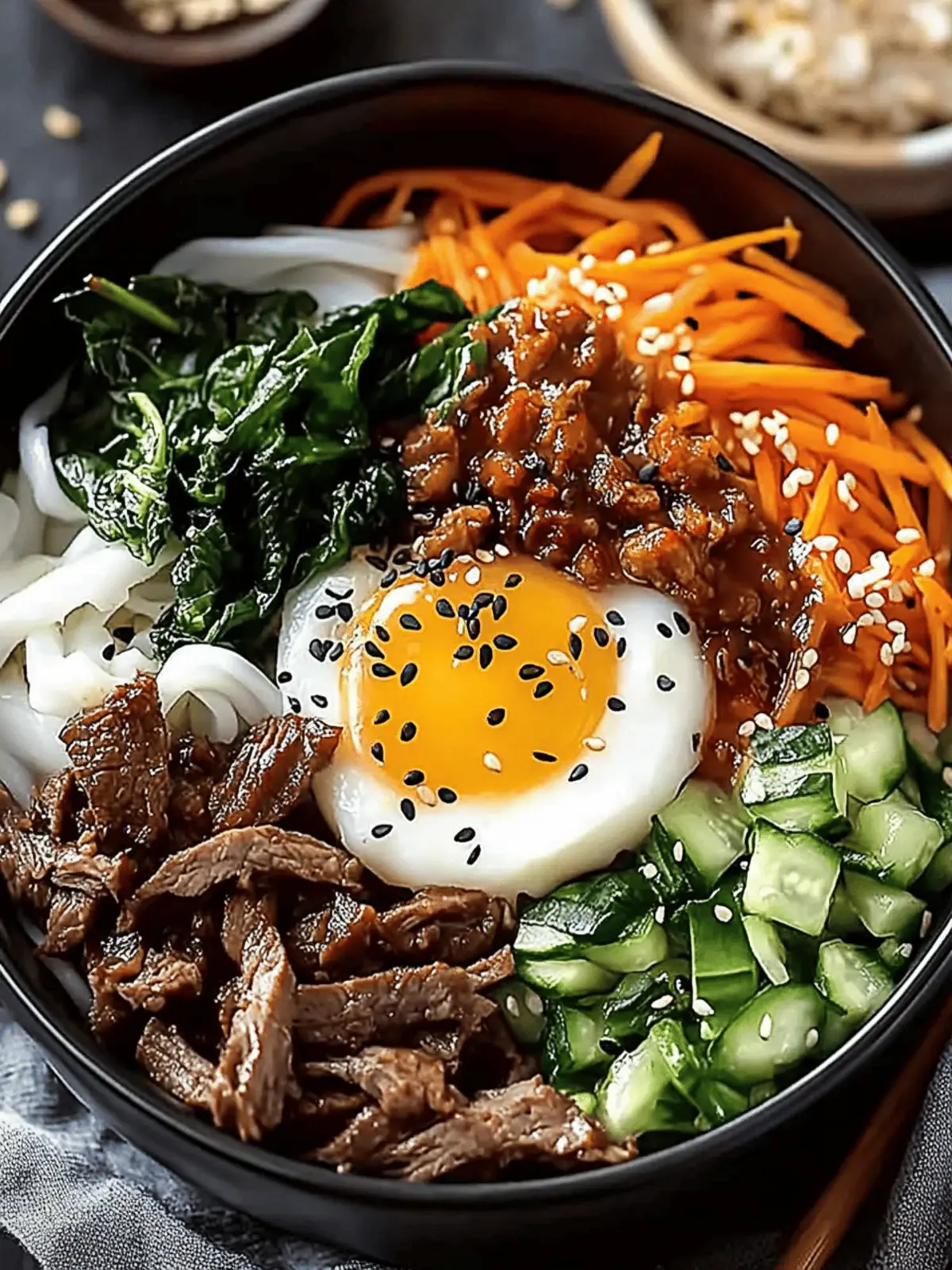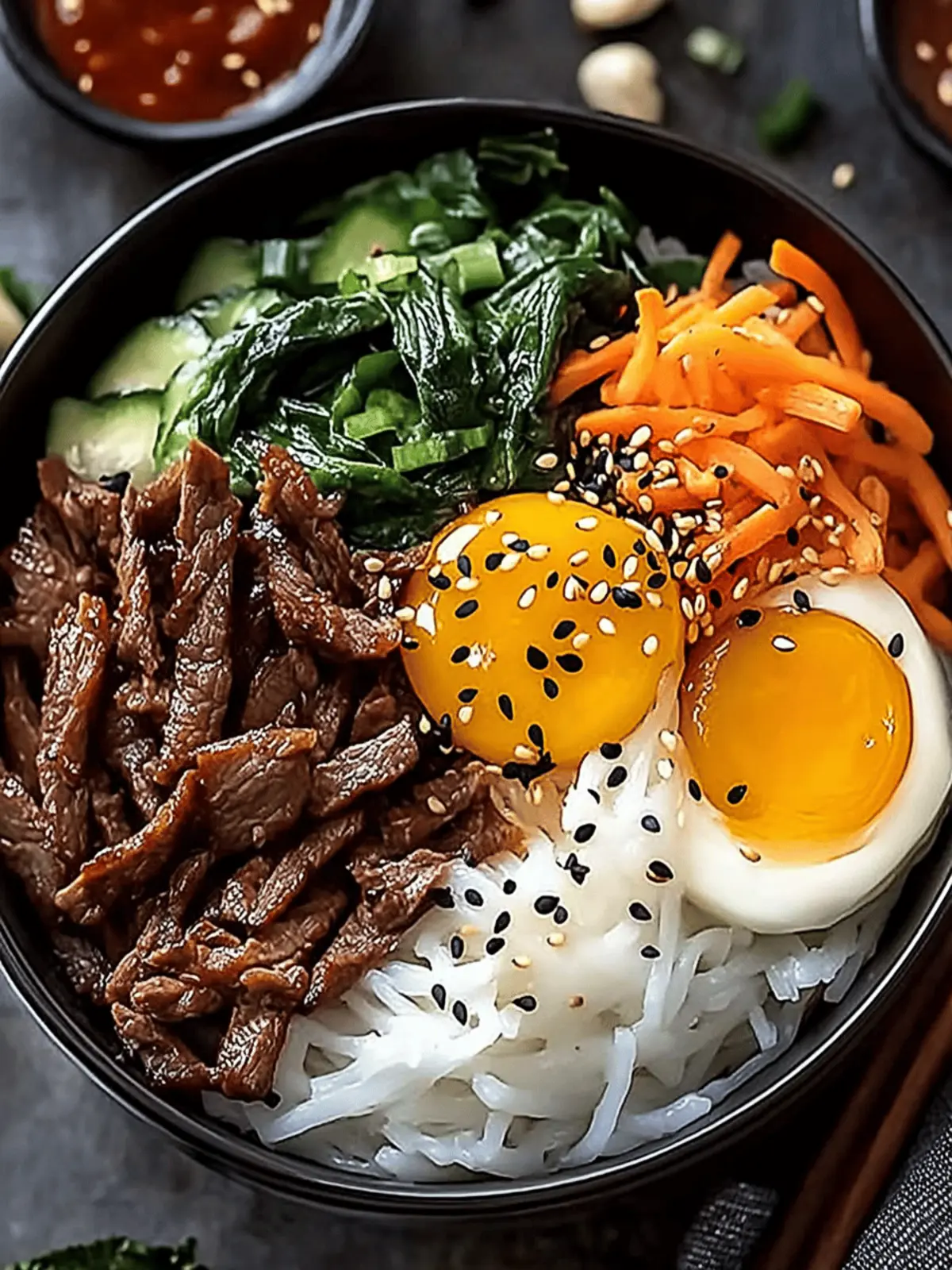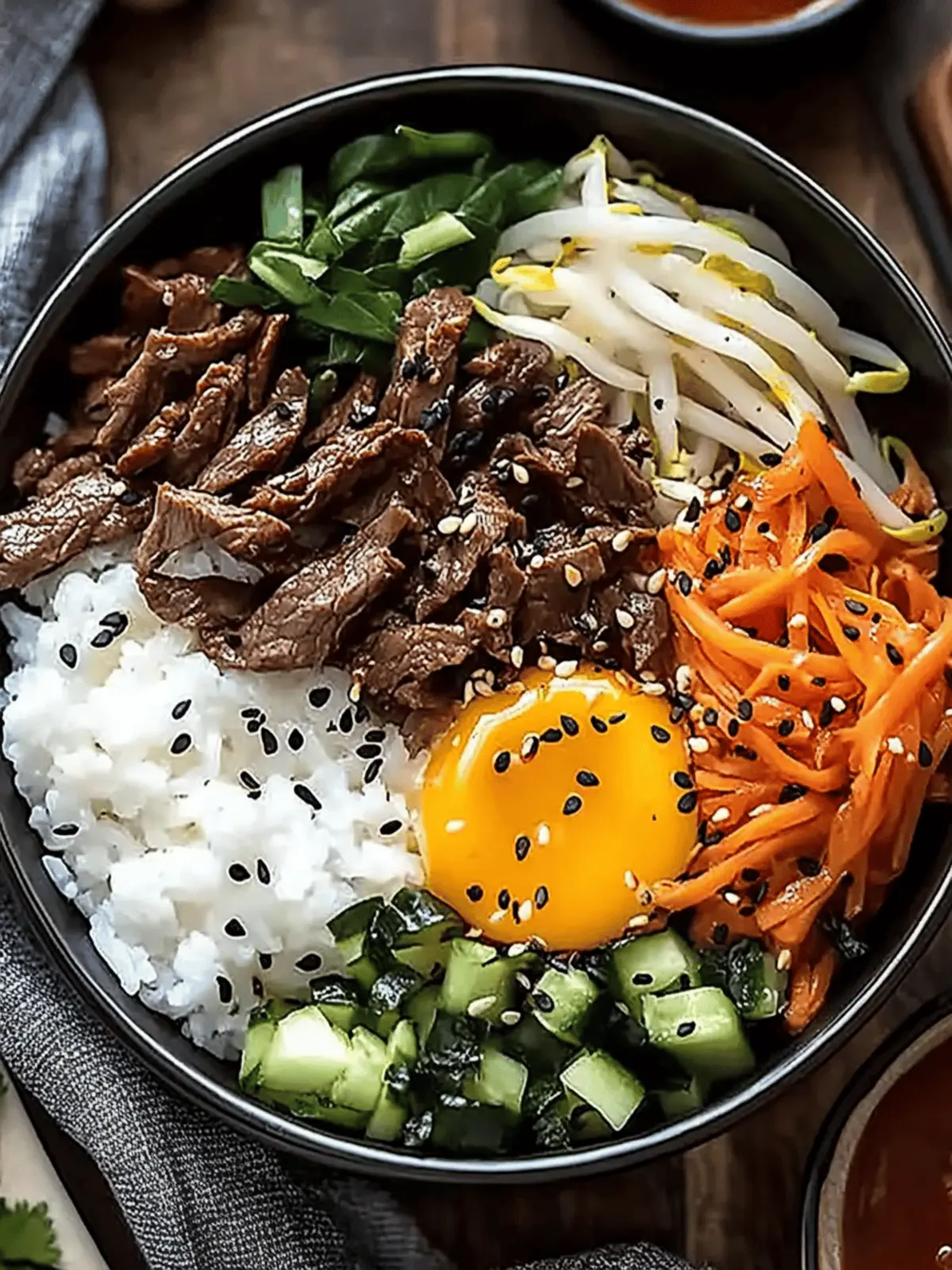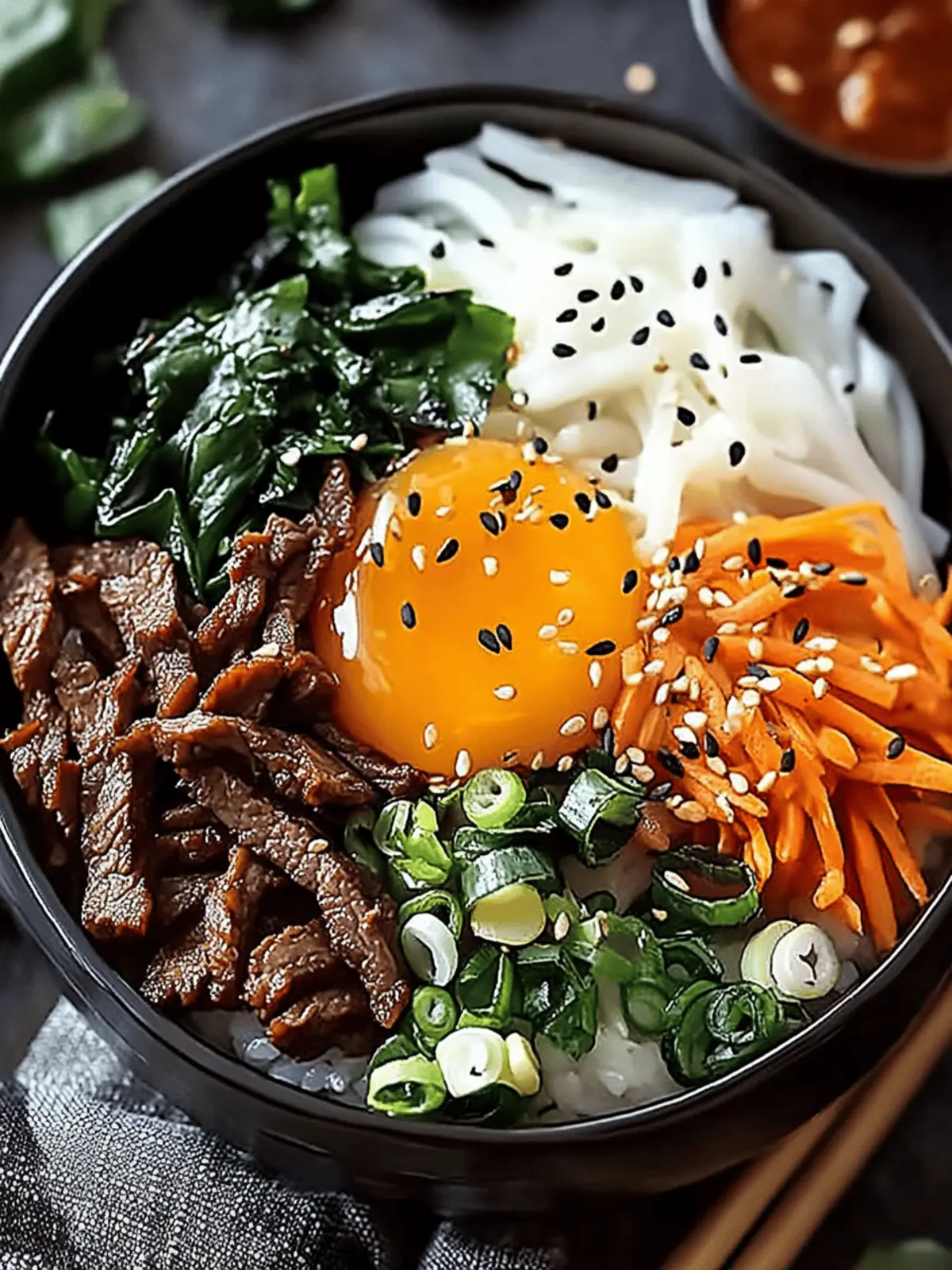When the craving for something flavorful hits, I often turn to my kitchen for a quick escape. That’s how I discovered the joys of the Korean Beef Bibimbap Bowl — a vibrant explosion of taste and texture that can transform an ordinary weeknight into a culinary adventure. Picture this: tender, marinated beef mingling with a rainbow of fresh veggies, all resting on a bed of warm, sticky rice. And let’s not forget the crowning jewel—a perfectly fried egg, its golden yolk ready to burst and enrich every bite.
What I love most about this dish is its versatility; you can customize it to suit any dietary needs or personal preferences. Feeling vegetarian? Swap out the beef for tofu, and you’ve got a delightful alternative without sacrificing flavor. This bowl is more than just food; it’s a celebration of simple ingredients coming together in harmony, perfect for impressing guests or treating yourself on a busy day. Let’s dive in and create this quick and customizable delight together!
Why is the Korean Beef Bibimbap Bowl special?
Explosive Flavor: The Korean Beef Bibimbap Bowl packs a punch with its rich, savory beef, crispy vegetables, and aromatic gochujang sauce.
Quick to Prepare: Perfect for busy nights, this recipe comes together in just under 30 minutes, making it an ideal choice for those who crave homemade food but are short on time.
Customizable: Easily adapt it to your taste—switch out the beef for tofu or tempeh for a delicious vegetarian alternative.
Colorful Presentation: The vibrant rainbow of ingredients not only looks stunning but makes eating a joy, appealing to all ages.
Nutritional Boost: With fresh veggies and protein-packed ingredients, this bowl offers a well-rounded, nutritious meal to keep you energized throughout the day.
Elevate your dining experience with other delightful variations and sauces to keep meals exciting!
Korean Beef Bibimbap Bowl Ingredients
For the Beef
- Ground Beef – Provides protein and savory flavor; substitute with tofu or tempeh for a vegetarian option.
- Gochujang Sauce – Adds spice and depth; adjust for heat or replace with sriracha for a similar kick.
- Low-Sodium Soy Sauce – Provides umami flavoring; tamari is a good gluten-free alternative.
- Sesame Oil – Enhances flavor profile; use olive oil as a neutral substitute.
For the Rice
- Short-Grain White Rice – Serves as the base; quinoa can be used for a gluten-free option.
For the Vegetables
- Carrots – Adds sweetness and crunch; swap with colorful veggies like bell peppers if desired.
- Spinach – Offers freshness and nutrition; kale or Swiss chard can be substituted.
- Zucchini – Enhances texture; can be replaced with mushrooms for a different flavor profile.
- Bean Sprouts – Adds crunch and texture; shredded cabbage makes a suitable substitute.
For the Topping
- Eggs – Provides richness as a traditional topping; consider avocado for a vegan alternative.
Feel free to mix and match to create your perfect Korean Beef Bibimbap Bowl!
How to Make Korean Beef Bibimbap Bowl
-
Cook the Rice: Follow the package instructions to cook the short-grain rice until tender, about 20 minutes. Set aside to let it steam and become sticky.
-
Brown the Beef: In a skillet, heat over medium-high heat and sauté the ground beef for 5-7 minutes, stirring occasionally until browned. Drain any excess fat for a lighter dish.
-
Add Flavor: Stir in gochujang sauce, low-sodium soy sauce, and sesame oil. Let it simmer for an additional 5 minutes for the flavors to meld beautifully.
-
Sauté Vegetables: In another pan, heat a bit of sesame oil over medium heat. Add sliced carrots, zucchini, spinach, and bean sprouts, sautéing for about 7 minutes until they are tender-crisp and vibrant.
-
Fry the Eggs: In a non-stick pan, fry the eggs sunny-side up for about 3 minutes, cooking until the whites are set but the yolks remain runny—just perfect for mixing into your bowl.
-
Assemble Bowls: Divide the cooked rice among bowls. Top each with the beef mixture, sautéed vegetables, and a fried egg. Drizzle with extra gochujang if desired for an extra kick.
Optional: Garnish with sesame seeds or fresh scallions for added flavor and crunch.
Exact quantities are listed in the recipe card below.
Make Ahead Options
These Korean Beef Bibimbap Bowls are perfect for meal prep enthusiasts! You can prepare the rice and sautéed vegetables up to 3 days in advance. Simply cook the rice according to the package instructions and let it cool before refrigerating in an airtight container. For the veggies, sauté your carrots, zucchini, spinach, and bean sprouts, then store them in a separate container to maintain their crispness. The beef mixture can also be made ahead—just cook it up, allow it to cool, and refrigerate for up to 3 days. When you’re ready to enjoy, just reheat the components in the microwave or on the stovetop, fry fresh eggs, and assemble your bowls. This way, you’ll have a delicious homemade meal waiting for you, saving you precious time on busy weeknights!
How to Store and Freeze Korean Beef Bibimbap Bowl
Fridge: Keep leftover components of your Korean Beef Bibimbap Bowl stored in airtight containers for up to 3 days to maintain freshness.
Freezer: If you want to save leftovers for later, freeze individual components separately in airtight bags for up to 2 months. Just remember to thaw in the fridge before reheating.
Reheating: Reheat each component gently in the microwave or on the stovetop until heated through. For best results, reassemble and warm the assembled bowl in the pan, allowing the flavors to meld once more.
Room Temperature: Avoid leaving cooked ingredients out for more than 2 hours to prevent spoilage and maintain safety.
Expert Tips for Korean Beef Bibimbap Bowl
-
Rinse the Rice: Rinse your short-grain rice thoroughly before cooking to remove excess starch, which prevents it from becoming gummy.
-
Marinate for Flavor: For enhanced taste, marinate the ground beef for at least 30 minutes (preferably overnight) before cooking to deepen the flavor profile of your Korean Beef Bibimbap Bowl.
-
Veggie Variety: Mix colors and textures by choosing a variety of vegetables; avoid overcrowding the pan while sautéing to ensure they stay crisp and vibrant.
-
Perfect Egg Technique: Cook the eggs just until the whites set, leaving the yolks runny. This creamy yolk is essential for achieving that rich, delicious finish to each bowl.
-
Store Separately: Keep leftover components stored separately in airtight containers; this preserves freshness and texture, helping you enjoy your meal within three days.
What to Serve with Korean Beef Bibimbap Bowl?
To create an inviting and memorable meal, consider delightful side dishes that complement your bibimbap’s vibrant flavors.
-
Kimchi: This traditional fermented side adds a tangy crunch that perfectly balances the savory nature of your bibimbap bowl.
-
Pickled Vegetables: Bright, tangy pickled carrots or radishes will enhance the freshness of the meal and offer a delightful contrast to the warm ingredients.
-
Seaweed Salad: With its umami flavors and chewy texture, a seaweed salad can bring a refreshing lift, perfectly harmonizing with the bibimbap.
-
Miso Soup: A warm bowl of miso soup serves as a comforting starter, enriching your experience with its earthy depth and a hint of umami.
-
Spicy Cucumber Salad: This crunchy, light salad adds a kick that complements the warmth of the bibimbap, enhancing the meal’s fresh essence.
-
Sesame Green Beans: Lightly sautéed and seasoned with sesame oil, these green beans introduce another layer of flavor and nutrition to your vibrant dining table.
Each of these options can enhance your Korean Beef Bibimbap Bowl experience, paving the way for a satisfying meal that celebrates diverse textures and tastes.
Korean Beef Bibimbap Bowl Variations
Feel free to mix things up and create your perfect bowl, bursting with your favorite flavors!
-
Vegetarian: Replace beef with tofu or tempeh, marinating it to infuse flavor while keeping the hearty texture.
-
Whole Grains: Substitute short-grain rice with quinoa or brown rice for a nutritious twist, elevating the bowl’s health factor.
-
Seasonal Veggies: Get creative by swapping in seasonal vegetables like radishes or asparagus, enhancing freshness and color.
-
Flavored Oils: Use chili oil or infused sesame oil for frying vegetables, giving them an exciting flavor boost that’s aromatic and delightful.
-
Spice It Up: Add chopped jalapeños or a sprinkle of red pepper flakes for extra heat, perfect for those craving a spicy kick.
-
Nutty Crunch: Incorporate toasted nuts or seeds as a topping, such as peanuts or pumpkin seeds, for a delightful crunch that complements the warm ingredients.
-
Gochujang Remix: Experiment with different sauces like spicy sesame dressing or a drizzle of soy sauce mixed with vinegar to create a unique flavor profile that suits your taste buds.
-
Pickled Accompaniments: Serve with homemade pickled carrots or kimchi for an added zing that complements the richness of your Korean Beef Bibimbap Bowl.
Advertisement
Korean Beef Bibimbap Bowl Recipe FAQs
How do I choose the right vegetables for my Korean Beef Bibimbap Bowl?
Absolutely! When selecting vegetables, look for fresh and vibrant produce. Choose colorful options like bright orange carrots, rich green spinach, and crisp zucchini. Ensure they are firm and free from dark spots—all signs of ripeness and quality. In addition, feel free to customize based on seasonality or preference; bell peppers, radishes, or even mushrooms can provide different flavors and textures.
What’s the best way to store leftover Korean Beef Bibimbap Bowl?
To maintain freshness, store leftover components in airtight containers for up to 3 days in the refrigerator. Be sure to keep the rice separate from the toppings to prevent it from becoming soggy. If you’re planning to enjoy it later, allow each component to cool before sealing; this helps keep flavors intact and prevents moisture buildup.
Can I freeze the Korean Beef Bibimbap Bowl components?
Yes, you can! For freezing, pack the components separately in airtight freezer bags. The ground beef mixture and cooked rice can be frozen for up to 2 months, while sautéed vegetables will maintain their quality for about 1 month. To reheat, thaw in the fridge overnight, then gently warm each component in the microwave or stovetop before assembling your bowl.
What do I do if my rice turns out too sticky or mushy?
Very common! If your rice becomes sticky, it’s often due to excess starch. To avoid this, rinse the rice thoroughly before cooking. If you find your rice has already turned mushy, consider blending it with some added cooked quinoa or using it as a base for fried rice to make a new dish rather than waste.
Are there any dietary considerations for making this dish pet-friendly or allergy-friendly?
For sure! If you plan to share your Korean Beef Bibimbap Bowl with pets, always check that the ingredients are safe for them. Avoid using ingredients like onions or garlic, which can be toxic to dogs. For allergens, substituting gluten-containing items like soy sauce with tamari makes it gluten-free, and swapping gochujang for a milder sauce can reduce spice for sensitive diners. Always consult dietary restrictions before serving!

Korean Beef Bibimbap Bowl - Quick, Flavorful & Customizable Feast
Ingredients
Equipment
Method
- Cook the rice according to package instructions until tender, about 20 minutes. Set aside to steam.
- In a skillet, heat over medium-high heat and sauté ground beef for 5-7 minutes until browned. Drain excess fat.
- Stir in gochujang sauce, low-sodium soy sauce, and sesame oil. Simmer for 5 minutes.
- In another pan, heat sesame oil and sauté carrots, zucchini, spinach, and bean sprouts for 7 minutes.
- Fry eggs sunny-side up in a non-stick pan for about 3 minutes.
- Assemble bowls with rice, beef mixture, vegetables, and fried egg. Drizzle with extra gochujang if desired.



